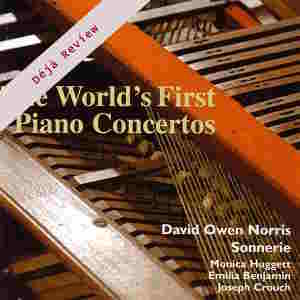
Déjà Review: this review was first published in July 2003 and the recording is still available.
The World’s First Piano Concertos
Johann Christian Bach (1735-1782)
Concerto in E flat, op. 7, 5 (1770)
Concerto in G, op. 7, 6 (1770)
Carl Friedrich Abel (1723-1787)
Concerto in B flat, op. 11, 2 (1774)
Wolfgang Amadeus Mozart (1756-1791)
Concerto in D (KV 107, 1) (1772, after JC Bach Sonata in D)
Philip Hayes (1738-1797)
Concerto in A (1769)
James Hook (1756-1791)
Concerto in D, op. 1, 5 (1770)
David Owen Norris (square pianos)
Sonnerie
rec. 2002, Music Room, Hatchlands, UK
Avie AV0014 [80]
In the second half of the 18th century the new fortepiano gradually pushed the harpsichord onto the sidelines. Alongside the ‘grand piano’ used on the concert platform, other kinds of ‘piano’ were developed, which were mainly used in private rooms and salons. Such an instrument is presented on this CD: the square piano, also called ‘table piano’. This instrument, which could be used both as a side table and as a musical instrument, was especially popular in England. One of the main builders of the instrument Johannes Zumpe, was born in Germany but left his country for Britain in 1761. The instrument used here for most of the items is a piano built by him in 1769, exactly the year the Concerto in A by Philip Hayes was composed, presented here as the ‘first piano concerto’ in the history of music.
In Britain the square piano became very popular, and by the end of the 18th century huge numbers of instruments were sold. But during the 19th century the square piano lost ground to the upright piano, the ‘home version’ of the concert grand. Until the end of the 19th century square pianos were built, though.
David Owen Norris implicitly questions the generally held view that square pianos were mostly used in private homes and by amateur musicians, and were inferior to the grand pianos for ‘serious’ music making. One of the characteristics of the square piano is described by Mr Norris: “… the dampers were raised, not by a sustaining pedal, but by two hand levers, one for the bass and one for the treble. This meant that notes rang on until a hand was free to ‘change’ the lever”. This situation was unchanged at the end of the century. It was different on the continent: the famous piano builder Anton Walter also built square pianos; they had a knee lever to operate the sustaining mechanism. And in Vienna, composers and professional musicians took the square piano very seriously.
David Owen Norris states that for more than two centuries, the fact that square pianos in Britain had only hand levers “has been perceived as a fatal disadvantage, ruling out Zumpe’s Square as a serious instrument: a puzzling verdict in view of its enormous commercial success.”
He also refers to the fact that a highly respected composer like Johann Christian Bach acted as an agent for Zumpe and performed on the instrument in public, which he wouldn’t have done if he had considered the square piano a kind of toy. Mr Norris closely studied the music by Johann Christian Bach and believes some of the characteristics of his keyboard music have been generated by the peculiarities of the square piano. Some of the harmonies only have an effect if the strings ring on. And he also believes that “the need to avoid blurring forced him to avoid writing too many notes”. He concludes that Johann Christian turned the peculiarities of the instrument to musical advantage.
The result as can be heard on this CD has convinced me. I have heard the concertos by Johann Christian before, and was never impressed; I often wondered where his reputation came from. For some reasons, I found the keyboard concertos, in particular if played on the fortepiano, bland and rather uninteresting. Having heard the performance here I have changed my mind. All of a sudden the concertos become quite dramatic. The other pieces on this recording are equally interesting and musically satisfying. Mr Norris has found in these concertos several characteristics that seem to refer to the square piano as the instrument that the composers had in mind. On this instrument they seem fully developed concertos in their own right and not just predecessors of the ‘real’ classical piano concerto.
All concertos are performed with two violins and cello. Any larger ensemble would drown out the square piano. That a performance with such a slight ensemble was common practice is proven by the three concertos by Mozart, all arrangements of keyboard sonatas by Johann Christian Bach. It is very likely that Mozart himself played on a square piano by Zumpe, as an instrument signed by Johann Christian Bach and built in 1778 has been found in France near the village where Johann Christian and Mozart met in 1778. It is an additional bonus that this very instrument is used here in Mozart’s Concerto in D.
But this recording isn’t only interesting from a historical point of view. The performance by David Owen Norris and Sonnerie is excellent: lively and dramatic, with great expression in the slower movements. The choice of tempi is very satisfying: most middle movements are marked ‘andante’, and they are played as such, not as ‘adagios’, as so often happens. Sometimes the tempo is held back for a moment – for example in the andante of Mozart’s Concerto in D – which has a great dramatic effect.
I would strongly recommend this recording which brings together a hardly-known instrument, fine music and excellent performances.
Johan van Veen
Help us financially by purchasing from




















